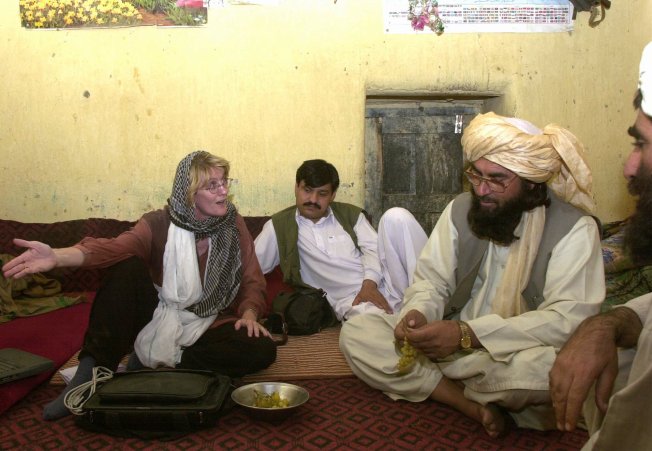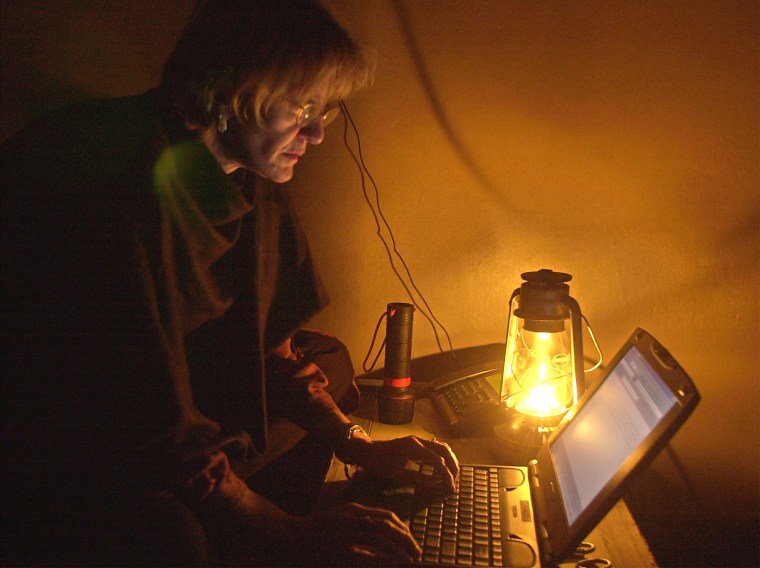Journalism in today’s Afghanistan is certainly wounded, but it’s far from dead. The evidence is produced daily, even hourly:
- At a Kabul press conference given by ex-President Hamid Karzai in February, the room was full of journalists. At least 12 TV cameras and multimedia reporters jockeyed for position at the back of the room to record the former president’s tongue-lashing of the U.S. administration after it took $3.5 billion dollars in Afghan foreign reserves and gave it to victims of the 9/11 attacks on the United States.
- When a powerful earthquake rumbled through Afghanistan’s eastern Paktika province in June, killing more than 1,000 people—destroying houses, families, entire villages—Afghan TV cameras were there, sending images and information to viewers nationwide.
- Also in June, Kelly Clements, the deputy high commissioner for the U.N. Refugee Agency, was in Afghanistan. I counted at least nine microphones pressing toward her. All but one or two belonged to Afghan news organizations.
- In July, Afghan media reported on a conference of religious scholars in eastern Afghanistan demanding education for all girls, as well as events such as a visit of Pakistani clerics to Afghanistan seeking Taliban help to find a peaceful end to an insurgency being waged by Pakistani Taliban in Pakistan’s border regions from bases in Afghanistan.
This is not journalism as it was before the Taliban took power last August, but it is journalism. It demands our respect and support. Sounding the death knell on journalism in Afghanistan is an insult to those tenacious Afghans who continue to report, edit, and broadcast under difficult conditions.
In my three decades working in Afghanistan, I’ve witnessed a lot of horrors — many of them committed by members of the previous, U.S.-allied administration. Associated militias of that administration carried out massacres when they ruled from 1992 to 1996. Their internecine fighting killed as many as 50,000 people, mostly civilians. I saw the bodies of women who were raped and scalped, and some of the thousands of children killed or maimed by booby traps left by warring mujahedeen groups. Yet the international community not only engaged with them, it partnered with them.
Today’s reality is that the Taliban are in power, ruling over a deeply conservative country and governed by strict tribal traditions that for centuries have given women little to no freedom. Still, the Taliban has a Ministry of Information and Culture and some strong voices in leadership who seem ready to engage. (Even before the Taliban came to power, most journalists had current Deputy Information Minister Zabihullah Mujahid on speed dial.) It’s not easy to be a journalist in Afghanistan—worse if you are a woman journalist—but it’s not impossible.
Some Taliban leaders, struggling to transition from war to governance, might like to turn back the clock.
More on Afghanistan’s media crisis
- Report: CPJ’s 2022 Afghanistan’s media crisis
- Afghanistan’s media faces crisis—and opportunity
- CPJ’s recommendations for protecting journalists and press freedom in Afghanistan
- Inside an Afghan news network’s struggle to survive
- Video: One year later
- Keeping hope alive
- Video: Journalists in exile
- ‘I thought about the efforts and struggles of two decades… and cried.’
- Video: Women journalists under pressure
- Press release
- Download a PDF of this report
When they last ruled, from 1996 to 2001, the Taliban banned television and photography, and there was only one government-controlled news agency doing any reporting. Then the country had just one computer, in southern Kandahar, and it was rarely, if ever, turned on. But this is not the Afghanistan of 1996. The internet is part of the fabric of the world now, and Afghans have become accustomed to having access to a significant number of television news channels, newspapers, and radio stations that did not exist before, as well as to social media networks—for all their flaws and falsehoods—that now flourish.
There is also resistance to the Taliban’s clampdowns on freedom now, whereas there was no such resistance when they last ruled. In May, when Taliban spokespeople said women had to cover their faces, even on television, male presenters at Afghanistan’s TOLONews all wore face masks for four days as a protest.
The number of women working at TOLONews is growing. Following the Taliban takeover last August, much of the staff of TOLO TV, which offered entertainment as well as news, fled the country. But TOLONews director Khpalwak Sapai stayed—and made it his job to hire women when their qualifications matched those of male candidates for the same position. Before the Taliban returned to power, TOLONews had 79 staff positions, of which 11 were for women, and 8 of those were journalists, owner Saad Mohseni told me. Today TOLONews has 78 positions, of which 21 are for women, all as journalists. The staffing is fluid, said Mohseni, but TOLONews has continued to hire women in greater numbers.
This is not to say that journalism is without cost. Sapai and two of his colleagues were detained in March over a report that the Taliban had banned all broadcasts of foreign drama series. Other journalists have been picked up and beaten for simply doing their job.
Yet every morning in Afghanistan journalists step out their door unsure what the day will bring, and ready to face it. One afternoon it might be a new edict curtailing women’s freedom, another it’s a thuggish intelligence agency—not unlike many other intelligence agencies around the world—making an arbitrary arrest. On still other days, if the journalist is a woman, she faces harassment for simply being a woman.
Journalists working in many parts of our increasingly polarized and angry world navigate similarly treacherous landscapes. Nevertheless, each day they step out their door. They show up at work and report as they can. They reaffirm each day what it means to be a journalist in a country ruled by a repressive regime that defines journalism as adherence to one version of the truth.

This is what Afghan journalists also do every day.
Looking back over the 20 years when the Taliban were out of power, the media industry grew at a remarkable pace. The proliferation of television news channels was rapid, and the number of young people who wanted to become journalists was inspiring. But the exodus of journalists that accompanied the collapse of Afghanistan’s Western-backed government begs questions about the training that was provided, as well as the extent and quality of support that was developed over those two decades.
The basic principle of journalism is independence, yet in post-2001 Afghanistan, the expansion of the news industry became, to a certain degree, an extension of the U.S.-led coalition’s mission. In this way, it was closely tied to both the new government and the international community that helped bring that government to power.
Some journalists were deeply critical of their Western-backed leaders and bravely told of the corruption that crippled progress, yet they also came to believe, consciously or not, that their survival was inexorably linked to the government’s survival—that the job of journalism was possible under some governments and not others.
That view is mistaken. Afghan journalists are now needed more than ever, and they need help inside of Afghanistan. Some journalists have been threatened and they have feared for their lives, but the only answer can’t be evacuation. You cannot evacuate every woman, every journalist. Evacuation, after all, is not the go-to strategy in any of the many other countries where journalists are under threat. Afghanistan, like other countries, needs journalists to speak truth to power.
It was easy to promote and nurture journalists in Afghanistan when the government and international community wanted journalism to flourish. Hundreds of millions of dollars flowed into the country toward that end. But now money is flowing out and help for journalists in Afghanistan is limited.
So what can be done? When the U.S.-led coalition was overseeing Afghanistan, journalists faced the threat of bombings and targeted killings—and not just by the Taliban. Reporters were outfitted with flak jackets, helmets, and given training in conflict reporting to help mitigate the dangers. Today the threats come from a repressive and rigid Taliban regime, and journalists need to be re-outfitted to mitigate the new dangers.
There are no quick fixes, which we in the West so often want, but we can begin to explore possibilities. Afghan journalists may be able to learn from others who work in similarly perilous situations, for instance. There are reporters the world over who know just how scary it is to work in repressive environments—and also know something about how best to navigate the dangers. They could be recruited and put in touch with journalists in Afghanistan. There would be language barriers, of course, but many talented translators are available, including in Afghanistan. And while circumstances are different the world over, the dangers journalists confront also have similarities. It would be wrong to underestimate the value of simple contact between journalists facing their own sets of troubles.
That’s just one form of professional backing. A second approach could involve emotional support. A team of counselors could be made available to provide a friendly ear and a professional voice to offer a different type of guidance. And these professionals don’t need to be outside of the country. Too often we in the West forget we have no monopoly on knowledge and talent. Afghanistan has a vast reservoir of skilled, smart people—some never left their country, not even for studies. Universities in Afghanistan have a proud history and have graduated talented professionals, even during the worst of times. There are doctors, psychologists, and professors who could perhaps work with trauma experts elsewhere, and in turn offer counseling to Afghan journalists when they need it, if they need it.
Lastly, journalism-advocacy groups should go into Afghanistan and establish offices there to better understand the landscape. They should talk to Taliban rulers—engage with them. No good will come from not talking to them.
Even in the best of cases, journalism is not easy. But without it we are hostage to lies. Truth dies, and rulers who seek to distort reality and repress individual freedoms—whoever and wherever they might be—win.
Kathy Gannon covered Afghanistan and Pakistan as a correspondent and bureau chief for The Associated Press for over three decades, from 1988 until May 2022. She will be the Joan Shorenstein Fellow at the Shorenstein Center at Harvard Kennedy School for the fall semester, 2022. The views expressed here are her own.
